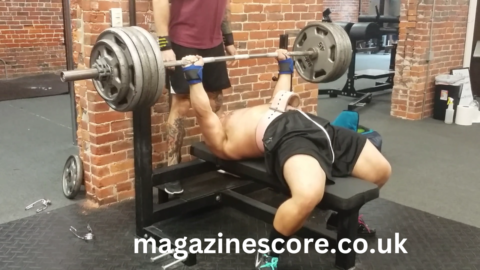The Nordic Ham string Curl is a bodyweight exercise that targets the hamstrings, an often-neglected muscle group that plays a crucial role in both athletic performance and everyday movement. This exercise has gained popularity due to its effectiveness in enhancing hamstring strength, flexibility, and injury prevention, making it an essential part of training regimens for athletes and fitness enthusiasts alike.
This comprehensive guide will delve into the mechanics of the Nordic Hamstring Curl, its benefits, proper form, variations, and how to incorporate it into your workout routine.
What is the Nordic Hamstring Curl?
The Nordic Ham string Curl is a bodyweight exercise designed to isolate and strengthen the hamstrings, which are the muscles located at the back of the thigh. Unlike other hamstring exercises, such as leg curls or deadlifts, the Nordic Ham string Curl primarily targets the eccentric phase of muscle contraction, meaning it focuses on the muscle’s ability to lengthen while under tension.
This exercise involves the slow, controlled lowering of your body from a kneeling position, relying on the hamstrings to control the descent. Once you reach the limit of your range of motion, you use your hands to help push yourself back up to the starting position.
While the Nordic Hamstring Curl is challenging, it provides numerous benefits for athletes and fitness enthusiasts looking to build hamstring strength, prevent injuries, and improve performance.
The Anatomy of the Hamstrings
Before diving into the specifics of the Nordic Ham string Curl, it’s helpful to understand the role of the hamstrings in the body.
The hamstrings are a group of three muscles that run along the back of the thigh:
- Biceps Femoris: The largest muscle in the group, located on the outer side of the thigh.
- Semitendinosus: Situated in the middle of the back of the thigh.
- Semimembranosus: Located on the inner side of the thigh, adjacent to the semitendinosus.
These muscles are primarily responsible for bending the knee (flexion) and extending the hip. They play an essential role in movements like running, jumping, squatting, and bending over.
Despite their importance, the hamstrings are often undertrained in comparison to the quadriceps (the muscles at the front of the thigh), leading to imbalances that can contribute to injuries. The Nordic Ham string Curl, due to its emphasis on eccentric training, is particularly effective in strengthening the hamstrings and addressing these imbalances.
Why is the Nordic Ham string Curl So Effective?
The Nordic Hamstring Curl is considered one of the most effective exercises for targeting the hamstrings because it focuses on eccentric contraction, which is the phase of muscle movement where the muscle lengthens under tension. Research has shown that eccentric training is particularly effective at improving muscle strength, increasing muscle mass, and enhancing injury prevention.
Key Benefits of Nordic Ham string Curls
- Strengthens Hamstrings: The exercise targets the hamstrings in a way that many other exercises do not, particularly by focusing on the eccentric phase. As a result, it helps develop strength through a full range of motion.
- Prevents Hamstring Injuries: Athletes who engage in high-speed activities, like sprinting and soccer, are often prone to hamstring injuries. Nordic Ham string Curls help mitigate the risk by strengthening the muscle’s ability to control deceleration during running or jumping.
- Improves Flexibility: The controlled lowering of the body in the Nordic Ham string Curl promotes both strength and flexibility in the hamstrings. Over time, this exercise can help increase the range of motion in the posterior chain.
- Enhances Performance: Strong hamstrings are essential for explosive movements like sprinting, jumping, and pivoting. By building hamstring strength, the Nordic Ham string Curl can help enhance overall athletic performance.
- Core Activation: Because the Nordic Ham string Curl requires you to maintain a rigid, upright posture as you lower your body, the exercise also engages the core muscles, helping improve overall stability and body control.
How to Perform the Nordic Hamstring Curl Correctly
Performing the Nordic Ham string Curl requires proper form and control to avoid injury and ensure maximum benefit. Here’s a step-by-step guide on how to do it:
Step 1: Setup and Positioning
- Kneeling Position: Start by kneeling on a soft surface like a mat or padded floor. Your knees should be at a 90-degree angle to the ground.
- Foot Anchoring: To perform the Nordic Ham string Curl, you’ll need your feet secured. If you don’t have a machine that holds your feet, you can have a partner hold them in place or anchor them under a piece of heavy furniture or a resistance band.
- Core Engagement: Keep your core tight and your spine neutral. This ensures that your body remains stable as you perform the movement.
Previous article; How to Crochet a Blanket A Step-by-Step Guide for Beginners
Step 2: Lowering the Body
- Controlled Descent: Slowly begin to lower your body forward, extending your knees and resisting gravity. Your hamstrings will be working hard to control this movement.
- Maintain a Straight Line: Try to maintain a straight line from your knees to your shoulders. Keep your chest and hips aligned as you descend.
- Go as Low as You Can: Lower your body as far as you can while maintaining control. Ideally, you want to reach the point where your body is almost parallel to the ground, but don’t push beyond your current capabilities.
Step 3: Return to Starting Position
- Push with Hands: Once you’ve reached the bottom of the movement, use your hands to push yourself back to the starting position. This helps reduce the strain on the hamstrings and ensures you can complete the movement without compromising your form.
- Gradual Progression: As you get stronger, try to reduce the amount of assistance you use from your hands, gradually relying more on your hamstrings to return to the starting position.
Step 4: Repetitions and Sets
Start with 3–5 repetitions per set, depending on your current fitness level. You can progress to more repetitions as your strength improves.
Nordic Ham string Curl Variations
While the classic Nordic Hamstring Curl is effective, there are several variations you can incorporate to increase the challenge or target different muscle groups.
1. Assisted Nordic Ham string Curl
If you’re new to this exercise or find it difficult, you can start with assistance. Use your hands on the ground or a bench to help you lower yourself and return to the starting position.
2. Eccentric Focus
In the eccentric version, you focus primarily on the lowering phase of the movement. Instead of using your hands to push yourself back up, you lower yourself slowly, then use your hands or a partner’s assistance to help you return to the top.
3. Nordic Ham string Curl with Resistance Bands
Using a resistance band provides extra assistance for beginners. Secure the band around your hips and anchor it to a stable surface. This can help you perform the exercise with less strain until you build more strength.
4. Single-Leg Nordic Ham string Curl
For advanced practitioners, the single-leg version of the Nordic Ham string Curl increases the difficulty by forcing one leg to support the entire body’s weight. This variation adds more intensity and further isolates the hamstring muscles.
How to Incorporate Nordic Hamstring Curls into Your Routine
The Nordic Ham string Curl is an advanced exercise, so it should be incorporated into your workout routine gradually, especially if you’re new to it. Here are some tips on how to include it in your training:
1. Warm-Up Properly
Before performing Nordic Ham string Curls, make sure to warm up your muscles with dynamic stretching or light cardio. This helps increase blood flow to the hamstrings and prepares them for the intensity of the exercise.
2. Frequency
Aim to include Nordic Ham string Curls in your training routine 1–2 times per week. Since it is an intense exercise, allow sufficient recovery time between sessions.
3. Combine with Other Hamstring Exercises
To ensure balanced hamstring development, combine Nordic Ham string Curls with other hamstring exercises like deadlifts, glute bridges, or Romanian deadlifts. This provides a comprehensive approach to strengthening the hamstrings.
4. Progressive Overload
As you get stronger, gradually increase the difficulty of the exercise. You can do this by reducing the amount of assistance you use, performing more repetitions, or progressing to more advanced variations.
Conclusion
The Nordic Hamstring Curl is an incredibly effective exercise for building hamstring strength, enhancing flexibility, and preventing injuries. By focusing on eccentric contraction, it improves the hamstrings’ ability to lengthen under load, a crucial function for athletic performance and injury prevention.
Incorporating this exercise into your training routine, whether for sports performance, injury prevention, or general fitness, will yield significant benefits. By performing the Nordic Ham string Curl with proper form and gradually progressing the difficulty, you can experience greater hamstring strength and overall lower body power.








